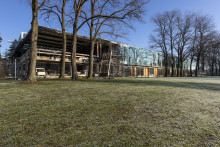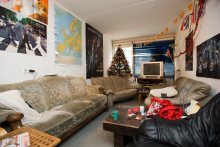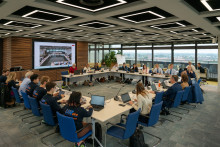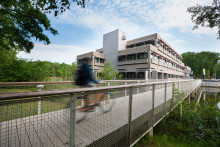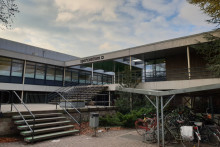The university has grown rapidly in recent years in terms of both staff and student numbers. The UT also expects ‘controlled’ growth in the coming years. As a result, campus facilities will come under further pressure, as can be read in the UT’s proposed Long-Term Strategic Housing (LTSH) plan. According to Executive Board member Machteld Roos, the demand for rooms for small-scale education increased in particular. ‘We want to take steps to fill that demand in the coming years.’
Occupation
There is less need for extra office space, reports the LTSH 2023-2032. Although the campus remains crucial, hybrid working has become more common due to corona. Therefore, the university wants to move towards a more flexible use of work and study places. The new real estate plans take into account an average presence on campus of 70 per cent. ‘People work from home more than before’, says Roos. ‘But that does not apply to everyone. It is also not possible for every function. We cannot and do not want to generalize.’
The UT currently has more than five thousand workplaces. This means that the university is well equipped, with 1.4 workplaces per FTE. The LTSH states that the UT takes into account a ‘flex factor’ for office spaces that can drop to 0.7 in the long term. The number raised some eyebrows during last Wednesday’s University Council. According to Roos, the figure is not yet set in stone. ‘But we do want to look at the occupancy because of changing preferences. Efficiency, cost and sustainability reasons also play a role. We will discuss this with all parties involved’, the Executive Board member emphasises.
Sports and culture
To meet the demand for teaching spaces and lab facilities, there are, for instance, plans for new construction on the Es. At the same time, work is underway on a ‘Sports and Culture masterplan’ to meet the growing need for sports and cultural facilities. ‘In particular, there are more wishes in the field of individual sports’, says real estate portfolio holder Nico-Tom Pen. ‘We want to expand the offering.’
As a provisional solution, an air-supported dome and temporary dance hall will be built on campus in the short term. But there are also plans for a permanent expansion of the Sports Centre and a Body & Mind Centre, according to the LTSH. ‘However, these are intentions’, emphasizes Pen. ‘In the LTSH, we describe developments and trends that we want to respond to. There are no concrete plans yet. Every year we review the situation, that is how the LTSH works.’
Caveats
This caution does not seem like a superfluous luxury. Caveats are therefore taken into account in the LTSH plans for 2032. There are numerous obstacles: a shortage of staff, fuel and building materials, which also affects the prices. In addition, there is uncertainty surrounding nitrogen and the ongoing energy crisis. The UT wants to tackle this last issue through sustainability. ‘We do that in different ways. First of all, we ask staff and students how they can save energy, for example by turning down the heating’, says Roos.
In addition, the planned renovations pay ample attention to sustainability, for which a roadmap has been drawn up in 2020. For example, 11.1% must be saved on energy needs by 2030, compared to 2020. ‘On paper, almost all buildings have an ‘A’ label for energy consumption’, says Pen. ‘But we want to become more sustainable, starting with the renovation of the Cubicus which starts at the end of 2023. The measures we take are very specific to each building – from radiator foil to solar panels on the roof. It is not so much about the age of a building, but about its technical and functional quality. That determines the urgency and order in which is renovated.’
Finally, the UT – together with its regional partners – wants to expand the number of student residences on campus. For this, the UT is dependent on other parties such as housing corporation De Veste, because the university is not legally allowed to invest its own resources in student housing. ‘Fortunately, the region is commited to work on this issue together’, Roos concludes.


